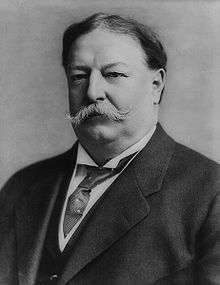Payne–Aldrich Tariff Act
The Payne–Aldrich Tariff Act of 1909 (ch. 6, 36 Stat. 11), named for Representative Sereno E. Payne (R–NY) and Senator Nelson W. Aldrich (R–RI), began in the United States House of Representatives as a bill raising certain tariffs on goods entering the United States.[1] The high rates angered Republican reformers, and led to a deep split in the Republican Party.
History
It was the first change in tariff laws since the Dingley Act of 1897.[2] President William Howard Taft called Congress into a special session in 1909 shortly after his inauguration to discuss the issue. Thus, the House of Representatives immediately passed a tariff bill sponsored by Payne, calling for reduced tariffs. However, the United States Senate speedily substituted a bill written by Aldrich, calling for fewer reductions and more increases in tariffs.[2]
An additional provision of the bill provided for the creation of a tariff board to study the problem of tariff modification in full and to collect information on the subject for the use of Congress and the President in future tariff considerations. Another provision allowed for free trade with the Philippines, then under American control. Congress passed the bill officially on April 9, 1909.[3]
Taft promptly appointed members to serve on the tariff board.
Impact of the bill
The Payne Act, in its essence a compromise bill, had the immediate effect of frustrating both proponents and opponents of reducing tariffs. In particular, the bill greatly angered Progressives, who began to withdraw support from President Taft. Because it increased the duty on print paper used by publishers, the publishing industry viciously criticized the President, further tarnishing his image. Although Taft met and consulted with Congress during its deliberations on the bill, critics charged that he ought to have imposed more of his own recommendations on the bill; namely, that of a slower schedule. However, unlike his predecessor (Theodore Roosevelt), Taft felt that the president should not dictate lawmaking and should leave Congress free to act as it saw fit.
Taft signed the bill. The debate over the tariff split the Republican Party into Progressives and Old Guards and led the split party to lose the 1910 congressional election. The bill enacted a small income tax on the privilege of conducting business as a corporation, which was affirmed in the Supreme Court decision Flint v. Stone Tracy Co. (also known as the Corporation Tax case).
References
- ↑ "Vote on Tariff Law Forced in the House" (PDF). The New York Times. April 2, 1910. Retrieved 2008-02-06.
- 1 2 "Payne-Aldrich Tariff Act". The Columbia Encyclopedia (6th ed.). Columbia University Press. 2007. Retrieved 2008-02-06.
- ↑ "Congress passes Payne-Aldrich Act". This Day in History 1909. The History Channel. Retrieved 2008-02-06.
Further reading
- Aldrich, Mark. "Tariffs and Trusts, Profiteers and Middlemen: Popular Explanations for the High Cost of Living, 1897-1920." History of Political Economy 45.4 (2013): 693-746.
- Barfield, Claude E. "" Our Share of the Booty": The Democratic Party Cannonism, and the Payne-Aldrich Tariff." Journal of American History (1970) 57#2 pp: 308-323. in JSTOR
- Coletta, Paolo Enrico. The Presidency of William Howard Taft (University Press of Kansas, 1973)
- Detzer, David W. "Businessmen, Reformers and Tariff Revision: The Payne‐Aldrich Tariff of 1909." Historian (1973) 35#2 pp: 196-204.
- Fisk, George. “The Payne-Aldrich Tariff,” Political Science Quarterly (1910) 25#1 pp: 35–68; in JSTOR
- Gould, Lewis L. "Western Range Senators and the Payne-Aldrich Tariff." Pacific Northwest Quarterly (1973): 49-56. in JSTOR
- Gould, Lewis L. "New Perspectives on the Republican Party, 1877-1913," American Historical Review (1972) 77#4 pp. 1074–1082 in JSTOR
- Solvick, Stanley D. "William Howard Taft and the Payne-Aldrich Tariff." Mississippi Valley Historical Review (1963) pp: 424-442 in JSTOR.
- Taussig, Frank W. The Tariff History of the United States (8th ed. 1931), pp 361–408
| ||||||||||||||||||||||||||||||||||||||||||


